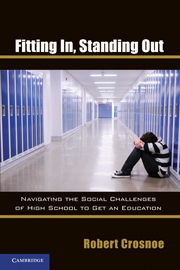Book contents
- Frontmatter
- Contents
- Acknowledgments
- PART I HIGH SCHOOLS AS CONTEXTS OF DEVELOPMENT
- 1 Pressures on Teenagers and Their Schools
- 2 A Day in the Life
- 3 The Two Sides of High School
- 4 Updating and Expanding Our Perspective
- PART II A CASE STUDY OF SOCIAL AND ACADEMIC EXPERIENCES IN HIGH SCHOOL
- PART III HELPING TEENAGERS NAVIGATE HIGH SCHOOL
- Works Cited
- Index
4 - Updating and Expanding Our Perspective
Published online by Cambridge University Press: 05 June 2012
- Frontmatter
- Contents
- Acknowledgments
- PART I HIGH SCHOOLS AS CONTEXTS OF DEVELOPMENT
- 1 Pressures on Teenagers and Their Schools
- 2 A Day in the Life
- 3 The Two Sides of High School
- 4 Updating and Expanding Our Perspective
- PART II A CASE STUDY OF SOCIAL AND ACADEMIC EXPERIENCES IN HIGH SCHOOL
- PART III HELPING TEENAGERS NAVIGATE HIGH SCHOOL
- Works Cited
- Index
Summary
What goes on in the informal processes of education filters into what goes on in the formal processes of education. This statement summarizes an already well-documented pattern in interdisciplinary research, but one that we can take further. I argue that there are two significant ways to push this line of research forward. The first is by contextualizing high school peer cultures in the larger historical moment, which will provide new insight into how the connection between informal and formal education plays out and why it matters. The second is by focusing less on the dichotomy between “good” and “bad” peer cultures and more on how the process of adaptation to peer cultures itself can transcend the “valence” of values and norms being promulgated in a school. My goal in delving into both is to set up high school peer culture as a current issue of educational policy that social and behavioral scientists can continue to inform in meaningful ways.
THINKING ABOUT SOCIAL CHANGE
Even though the connection between the informal and formal processes of education in American high schools has clear elements of timelessness, it does vary in ways that add a timely component to that timelessness. Indeed, we are now in a historical moment in which this connection is reshaping itself and, in the process, is likely becoming more intense. In particular, four historical, societal trends need to be incorporated into the integrative model depicted in the past chapter. In short, dramatic changes in the demography of the U.S. youth population, the reorganization of the American educational system, the revolution in communication/information technology, and the restructuring of the national and global economy are changing the implications of the social side of schooling for how teenagers' lives turn out.
- Type
- Chapter
- Information
- Fitting In, Standing OutNavigating the Social Challenges of High School to Get an Education, pp. 63 - 80Publisher: Cambridge University PressPrint publication year: 2011



